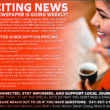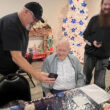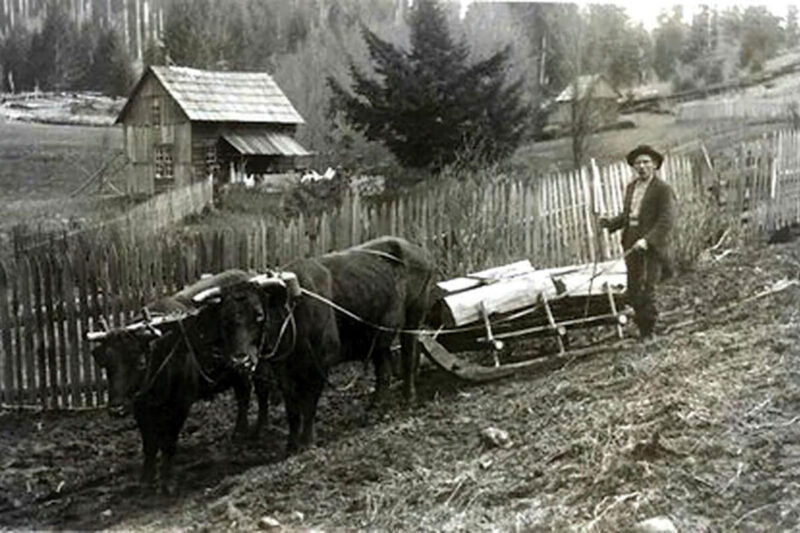Roberta McKern
As we meander through the East Linn Museum, we likely don’t have cattle in mind until we come across lariats, saddles, mohair chaps and a branding iron in its tack room. Although some of the branding irons actually were used on logs during drives down the Santiam and Calapooia rivers, when we see them, we automatically think of cowboys, cattle herds and “get along, little dogie.”
If local history comes to mind, we know steers once trailed from here over the Santiam Pass by the old toll road at 25 cents per score (20) for critters and 6 cents per horse and rider. Bound for the bunch grass prairies of Eastern Oregon, the bovines would fatten up and then be driven further east to gold mines or the railheads of Nevada or Utah.
Stock raising and moving cattle herds east or to high prairies like Gordon Meadows on Swamp Mountain is one way cattle tracks influenced our history. But first the track was left by oxen. This, of course, is the emigrant tale. As for the bovine ilk, emigrants traveled with beef animals plus dairy cows besides oxen, but oxen pulled many wagons headed west.
When oxen wore out between Independence, Missouri and the Willamette Valley, oftentimes a team would consist of an oxen and a horse or even a milk cow. But oxen were the first choice for pulling the pioneers’ heavy wagons because they relied on grass alone for fodder as compared with horses. They were strong but slower than horse teams. Plus, they were more likely to plod along until they dropped in their yokes.
Strong as an ox. Dumb as an ox. But more patient and docile, we believe, than a horse. An ox, of course, is a glorified steer chosen for size and strength as well as a peaceful temperament.
At the museum they’ve mainly left their track regarding the Oregon Trail in the research room, where copies of emigrants’ memories reside. One emigrant remembering his trip across the plains in 1851 was Philemon Vawter Crawford, for whom the town of Crawfordsville is named. His party arrived in good shape because, as he emphasized, it treated the oxen and other stock with consideration, giving them extra time to rest and graze when the grass grew lushly.
To come to Oregon from one of the jumpoff points in Missouri or Iowa was quite a journey. As Crawford noted at the end of his account, the emigrants “lived a camp life for five months and fifteen days while traveling 2,270 miles through Indian country with ox teams. His account ends on September 22. They’d started in the spring and arrived in the fall.
For less-fortunate emigrants who had lost most or all of their stock, godsends came when they were met by those who’d arrived earlier with fresh oxen and provisions if someone riding ahead passed the word that unfortunates were on the way. While it was still in operation, the Hudson’s Bay Company offered emigrants the option of renting stock because it paid better than selling the animals. We assume this meant renting oxen, perhaps horses and milk cows, but not steers destined for barbecuing.
Once here in Oregon, oxen went back to their ages-old traditional duties of pulling wagons and plows and of being driven over piles of grain to break the chaff off the kernels. Before Richard C. Finley built the first grist mill south of Oregon City, it took up to two weeks for grain to be hauled to and from Hudson Bay’s grist mill by ox cart.
At the museum, the physical track of the ox shows up better in logging than on the emigrant trail. East Linn has two ox yokes, one used by the Sawyer brothers near Holley. This abandoned yoke was found under a barn. If we compare it with one near the blacksmith display, it doesn’t seem like the bulls used were particularly large.
Since oxen were chosen for strength and size, some steers selected for training could get up to 1,800 pounds. There’s a photo in the logging section of teams of oxen pulling a snake of logs chained together down a skid road. Notably, the history of logging with oxen shows up in some familiar logging phrases, such as “bull-buck” for boss and “bull-of-the-woods” suspenders, red.
The museum has, too, a couple of ox shoes. They came in two parts, as befitting a cloven hoof. Some museum people like to point at a somewhat quarter-moon shaped object and ask “And what do you think this is?” of visitors. As far as we’ve learned, oxen now have a presence only in museums or historical writings, so why we should know what an ox shoe is makes a good question.
When it comes to the emigrant trail, the museum has a picture of two oxen pulling a wagon. It is on felt and identified the Sweet Home Junior Chamber of Commerce which is as gone, as are oxen from the landscape. Maybe the ghosts of oxen are somewhere standing in fields of ox-eyed daisies and buttercups. Not an ideal diet for bovines, yet buttercups bring to mind dairy cattle. Here the track of the cow grows strong at the museum.
Milk cows generally mean butter, and we cannot doubt the importance of that. This is emphasized by the way butter is chemically stretched and imitated. Well over 100 years ago, imitation butter made from cottonseed oil became available.
Many emigrants traveling down the Oregon Trail who took dairy cows along had fresh butter for most of their trip, or at least as long as the cow remained healthy enough to be milked. Just by hanging a pail of fresh cream from the back of the wagon, butter could be made. The jouncing of the wagon and sway of the bucket in accordance with the rough uneven ground of the prairie allowed butter to form in the sloshing cream.
Instead of a moving wagon with a tailgate, the museum features a variety of churns in addition to several cream separators. The most noticeable churn, of course, is Norval Rice’s patented churn with cedar fan. It dominates the model kitchen in the annex.
For one thing, it has a hand-cranked mechanism fitted to a ceramic container holding the cream and dasher. The crank is meant to operate the dasher and the attached fan by way of a missing leather belt. We don’t know if the fan is to cool the churner or the cream, or to keep off flies. The churn didn’t catch on, and Norval Rice is said to have traded the patent for a herd of Idaho ponies.
Otherwise, much butter making paraphernalia lurks near a churn collection in the main room. This includes a number of butter molds plus a wooden paddle and bowl. Not far away sit shelves of glassware and china in which milk and cream pitchers are located and at least one metal butter dish.
Before 1920, when most of America was considered rural, small towns like Sweet Home were dotted with barns and cow pastures plus hog pens and hen houses, especially homes located on the town’s edge. We know Sweet Home was surrounded by cow pastures because the first jail built was in the middle of one, so the caterwauling and complaints of occasional occupants could not be heard by townspeople who did not wish to be disturbed.
And for many people, moving to a town of 200 or so from a farm meant that keeping a cow was almost second nature. A cow taught older children responsibility and kept them occupied. It also brought in a little extra income when the oldest boys were of an age to deliver milk to neighbors. Two or three cows meant a mother could increase family income by selling butter and eggs to a local merchant or by trading them for extra goods.
A peculiar-looking wooden three-legged stool rests near milk and cream bottles in a museum display case. Many who are older recognize it is a milking stool. Likely, we can remember an elderly relative, as old as we are now, smacking her lips and declaring, “Oh, that Jersey cream. Nothing like that cream from a Jersey cow.”
The track of the cow certainly shows up in the old-fashioned cookbooks on the museum’s kitchen table, like the “White House Cookbook” featuring Grover Cleveland’s much younger wife and marking his years as President from 1885 to 1889 and 1893 to 1897. Then those who could afford it ate well. Ladies following the cookbook’s recipes received such instructions as “take a piece of butter the size of a walnut” or “take a chunk of butter the size of a small hen’s egg.” Obviously, it advantaged cooks to know what size walnuts and small hen’s eggs were – most likely, country girls.
However, in the museum’s parlor is a sign of things to come regarding cows and milk maids: a stereoscope view depicting a regimented line of dairy cows at stalls and connected to milking machines on a New Jersey farm. In the early 1900s, this scene was considered exotic enough to be included among foreign market ones. It predicted the future of concentrated agribusiness, when fewer and fewer people would have cozy associations with their milk cows at least.
No longer will the World War I song about “K-K-K-Katy” apply, wherein her admirer will await her coming “when the m-m-m-moon shines over the c-c-c-cowshed” and he’ll be at the “k-k-k-kitchen door.”
Basically, we are just looking at the ways in which cattle tracks manifest themselves in the East Linn Museum, but we can mention a couple of local uses of cow horns. For one thing, they were made into powder horns, and two of these hang among the guns. Also, one horn was used for hunting and calling to the dogs as a hunting horn. There is, too, an embossed leather picture of pioneer wagons, likely done on cowhide. But horses, not oxen, pull the wagons.
The East Linn area has seen farming, stock-raising and logging, with some mining thrown in to boot. The ox, steer and milk cow have all played their parts. Even at Quartzville were the White Bull and the Red Bull mines. What we see of cattle tracks at the museum may be trivial and mundane, but it underscores an association we humans have had with bovine kind for thousands of years.
Maybe we can learn something from Phileman Vawter Crawford and give more understanding to our associations with the animals upon which we depend. Or maybe we can follow the example of cattle who have strong herd instincts by working better together. And where is a better place to start than by volunteering at the East Linn Museum, where cooperation is a general given and where volunteers are always needed.
In the meantime, cattle tracks of one kind or another will stay in mind through myths, legends and rhymes. The mythic Minnesota logger, Paul Bunyan, brought his big blue ox, Babe, west with him when logging companies moved in our direction, and we certainly don’t forget cowboys and cattle trails, nor that the cow jumped over the moon!





